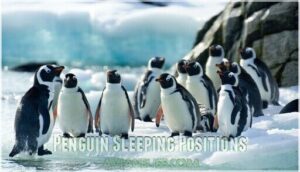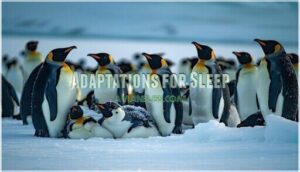This site is supported by our readers. We may earn a commission, at no cost to you, if you purchase through links.

They take numerous short naps called microsleeps throughout the day and night instead of one long snooze.
Penguins often sleep standing up, balancing perfectly on their feet with their heads tucked toward a shoulder or wing.
Some species, like the Chinstrap penguin, take hundreds of these microsleeps daily, each lasting only seconds.
When sleeping on land, they’ll gather in groups for warmth and protection, while at sea, they can sleep floating on the water’s surface.
Their specialized half-brain sleep allows them to remain alert for predators even while catching some shut-eye, using this unique ability to stay safe.
Table Of Contents
- Key Takeaways
- How Penguins Sleep
- How Do Penguins Sleep
- Penguin Sleep Locations
- Penguin Sleeping Positions
- Penguin Sleep Duration
- Sleeping With Eyes Open
- Adaptations for Sleep
- Environmental Influences
- Frequently Asked Questions (FAQs)
- Do Penguins sleep?
- How do penguins enjoy swimming in the summertime?
- Why do Penguins sleep standing up?
- Do Penguins sleep with a pillow?
- Do penguins sleep standing up or lying down?
- How do penguins usually sleep?
- Do penguins nap 1000 times a day?
- What animal takes 10,000 naps a day?
- What do penguins dream about?
- Do penguins dream during sleep?
- Conclusion
Key Takeaways
- You’ll find penguins don’t sleep like humans—they take thousands of microsleeps lasting just seconds each, which add up to about 11 hours of total sleep daily.
- Unlike your long nighttime slumber, penguins use unihemispheric sleep where half their brain rests while the other half stays alert with one eye open for predator awareness.
- You’ll see penguins sleeping in different positions depending on their environment—standing up to minimize heat loss in frigid conditions or lying on their bellies in warmer climates.
- Their sleep adaptations include remarkable insulation through dense feathers, specialized blood circulation for heat retention, and group sleeping for warmth and protection.
How Penguins Sleep
You’ll be amazed to learn that penguins don’t sleep like you do, as they take hundreds of microsleeps lasting just seconds throughout the day instead of one long rest period.
Penguins snooze in hundreds of lightning-fast microsleeps—just seconds long—instead of one deep slumber like humans do.
These brief naps add up to about 11 hours of total sleep daily, allowing penguins to stay alert for predators while still getting the rest they need, which is crucial for their survival due to the need for predators awareness.
Unique Sleep Patterns
While humans enjoy long, uninterrupted sleep, penguins have developed some of the most unusual sleep patterns in the animal kingdom.
Their unique sleep behavior might surprise you:
- They experience over 600 microsleeps per hour
- Each microsleep averages just four seconds
- Their sleep fragmentation allows constant vigilance adaptation
- Penguin sleep habits follow cathemeral rhythms (active irregularly day and night)
- They accumulate 11+ hours of total daily sleep despite the polyphasic nature
Polyphasic Sleep Cycles
Unlike our nighttime slumber, penguins follow polyphasic sleep cycles, fragmenting their rest into numerous short periods throughout the day.
You’d be amazed to learn these birds fall asleep thousands of times daily, with each nap lasting just seconds.
Despite this seemingly disruptive pattern, penguins efficiently accumulate over 11 hours of total sleep daily.
This unique approach to sleep cycles helps with energy conservation while maintaining constant vigilance against predators.
Microsleeps and Their Importance
While polyphasic sleep might seem inefficient, penguins rely heavily on microsleeps for survival.
These brief naps, lasting just 4 seconds on average, add up to over 11 hours daily.
Microsleep benefits include:
- Energy conservation during harsh Antarctic conditions
- Maintaining vigilance against predators through partial brain alertness
- Supporting essential cognitive function despite never entering deep sleep
You’ll be amazed that penguins experience over 600 microsleeps hourly, a remarkable penguin sleep adaptation.
Their dense feathers aid in temperature regulation, which is crucial for their survival.
How Do Penguins Sleep
Anyone studying penguin sleep behavior might be amazed by their unique rest patterns.
Unlike human sleep cycles, these remarkable birds have evolved fascinating adaptations to survive in harsh environments.
Here’s how penguins actually sleep:
- They take hundreds of microsleeps lasting just seconds instead of long periods
- They can sleep with one eye open to maintain predator awareness
- Many species sleep standing up to minimize heat loss
- Their sleep evolution allows them to accumulate over 10 hours daily despite brief naps
- Some penguins experience sleep deprivation during breeding seasons
You’d never guess these tuxedo-clad birds have such unusual sleep patterns!
Penguin Sleep Locations
You’ll find penguins sleeping in a variety of surprising locations, from standing upright on icy Antarctic shores to floating peacefully at sea where they can nap for months during their oceanic journeys.
Unlike humans who need a dedicated bedroom, these remarkable birds have adapted to rest wherever they happen to be, whether huddled in protective group formations on land or bobbing alone on ocean currents, which is a surprising adaptation that allows them to thrive in harsh environments, making them highly adaptable creatures.
Sleeping on Land
On land, penguins display fascinating sleep behavior suited to their environment.
When catching some shut-eye on solid ground, they adapt their positions based on species and climate.
| Species | Preferred Position | Location Choice |
|---|---|---|
| Emperor | Standing upright | Open ice fields |
| African | Lying down | Burrows or shelters |
| King | Belly position | Rocky shorelines |
Group rookeries provide protection from terrestrial predators, while burrow usage offers shelter from harsh weather conditions, making them a critical part of penguin survival, and their unique adaptations are a key aspect of their behavior, showcasing their ability to thrive in harsh environments.
Sleeping at Sea
Penguins don’t limit their rest to solid ground.
These remarkable birds take floating naps while at sea, tucking their bills under their wings to conserve heat.
During ocean naps, penguins alternate between slow-wave sleep and brief periods of alertness.
They’ll often hold their breath during underwater sleep cycles, using their exceptional underwater vision to remain vigilant for predator evasion, even as wave action gently rocks them, in a state of brief periods of alertness.
Sleeping in Groups
Within the bustling rookery, penguins find strength in numbers when it’s time to rest.
You’ll notice these birds take group sleeping seriously for several practical reasons:
- Huddle warmth provides social thermoregulation in freezing conditions
- Predator defense improves with more watchful eyes
- Shared safety increases survival rates
- Community bonds strengthen during rest periods
- Penguin colony sleep creates a microclimate up to 35°C warmer than outside
Their feathers have specialized oil glands to stay waterproof and this adaptation is crucial for their survival, showcasing their unique ability to thrive in harsh environments with specialized features.
Penguin Sleeping Positions
You’ll find penguins sleeping in various positions depending on their species and environment, from standing upright on ice to lying flat on their bellies with beaks tucked under flippers.
While emperor penguins often stand to sleep in frigid Antarctic conditions, king penguins and those in warmer climates typically rest horizontally, similar to floating ducks.
Standing Up While Sleeping
While exploring penguin sleeping spots, you’ll notice a remarkable sight: many species sleep standing up.
This unusual position serves multiple purposes in their icy environment.
Standing minimizes contact with cold surfaces, providing essential foot insulation and energy conservation.
Emperor penguins particularly favor this position due to rocky terrain in their habitat.
During huddling behavior, they’ll remain upright, sharing warmth while balancing on their feet—an impressive adaptation in penguin sleeping patterns, which is a result of their need for energy conservation.
Lying Down While Sleeping
Despite popular belief, not all penguins sleep standing up. In warmer climates, you’ll find many species lying down while sleeping, particularly on their bellies.
King penguins often prefer belly sleeping, resembling floating ducks. African penguins typically sleep lying down in burrows, gaining additional protection from predators.
Burrow sleeping offers climate influence benefits beyond warmth—it shields from wind and rain. Their feathers provide critical thermal regulation for this behavior.
Species variation in penguin sleep positions largely depends on their habitat’s conditions and thermal regulation needs.
Tucking Heads Away
While lying down provides comfort, tucking their heads away serves multiple survival purposes for penguins.
This bill position helps with:
- Thermal regulation by preventing heat loss through exposed beaks
- Weather protection during harsh Antarctic conditions
- Conserving energy during long periods of rest
- Creating a microclimate that maintains body temperature
You’ll often observe this behavior during egg incubation, when penguins need to maximize warmth for their developing chicks, which is crucial for their survival.
Penguin Sleep Duration
You’ll be amazed to learn that penguins don’t sleep like we do, instead taking thousands of microsleeps that last only seconds but add up to 11 hours daily.
Different penguin species vary in their total sleep time, with Emperor Penguins averaging 10.7 hours while Galapagos Penguins rest for nearly 13 hours each day, showcasing a significant variation in sleep time.
Average Sleep Time
While penguins sleep in different positions, the total amount they rest might surprise you.
On average, emperor penguins sleep approximately 10.7 hours daily—but not all at once.
Their daily sleep comes in short intervals, with typical naps lasting just 4-7.5 minutes.
During food deprivation, penguins sleep longer to conserve energy.
Most shocking? During egg incubation, emperor penguins may sleep nearly 24 hours to maintain their strength.
Variations by Species
The remarkable diversity among penguin species extends to their sleeping habits.
King penguins and larger species typically sleep on their bellies, taking over 10,000 four-second naps daily, totaling more than 11 hours of sleep.
Chinstrap penguins employ similar microsleep patterns, while smaller species often retreat to burrows for rest.
Emperor penguins have been extensively studied under natural conditions, revealing sleep patterns that likely mirror those of other penguin species—frequent microsleeps accumulating to substantial daily rest.
These microsleeps are essential for penguin fitness, especially in harsh environments.
Factors Affecting Sleep Duration
While different species show unique patterns, several factors influence how long penguins sleep.
Food deprivation forces penguins to sleep longer, conserving precious energy when meals are scarce.
You’ll notice these penguin sleep adaptations vary with:
- Environmental stressors like extreme temperatures
- Seasonal changes affecting daylight hours
- Egg incubation periods (Emperor penguins may sleep nearly 24 hours while incubating!)
These clever sleeping habits help penguins survive in some of Earth’s harshest environments, and are a key part of their survival strategy.
Sleeping With Eyes Open
You’ll be amazed to discover that species like emperor and Humboldt penguins can sleep with one eye open, using a technique called unihemispheric sleep where half their brain remains alert.
Half their brain sleeps, half stays alert—penguins master the art of resting while watching their backs.
This remarkable adaptation allows them to rest while maintaining constant vigilance against predators, similar to how sea lions and beluga whales protect themselves in their vulnerable moments, utilizing a unique form of rest that enables them to remain safe.
Unihemispheric Sleep
Did you know penguins have mastered a sleep trick few animals can perform?
During unihemispheric sleep, only half their brain rests while the other half stays alert.
They keep one eye open—the one connected to the awake hemisphere.
You’ll find penguins nodding off an astonishing 10,000+ times daily, with each sleep bout lasting just 4 seconds on average.
This remarkable adaptation guarantees constant visual awareness and auditory alertness to potential threats.
Predator Awareness
Auditory vigilance remains a penguin’s secret weapon during their minimal slumber.
You’ll find these birds can actually distinguish between familiar and unfamiliar sounds while sleeping! Their remarkable predator avoidance system allows them to stay alert to potential threats through unihemispheric sleep patterns.
They’ll wake instantly when detecting predator sounds, unlike humans who might sleep through danger.
This safety mechanism has evolved specifically for penguin sleeping habits in environments where vigilance means survival.
Visual Vigilance
While resting, penguins maintain impressive visual vigilance through unilateral eye closure, allowing one brain hemisphere to stay alert while the other sleeps.
This remarkable adaptation enhances their predator detection capabilities in harsh environments.
- You’d be amazed how penguins can spot danger while barely getting any minimal deep sleep
- Their terrain adaptation skills let them rest safely even on precarious rocky ledges
- These clever birds can differentiate between harmless sounds and potential threats, never fully letting their guard down, utilizing their unique ability to rest while still being alert
Adaptations for Sleep
You’ll be amazed by how penguins have developed specialized features to sleep in the harshest environments on Earth.
Their dense plumage acts as waterproof insulation while their unique blood circulation system maintains heat, allowing them to rest standing up or huddled together without freezing, which is a remarkable adaptation.
Insulation and Plumage
While some penguins keep one eye open for threats, their plumage provides critical protection during sleep.
Penguins’ feather density creates exceptional insulation against harsh cold climates. Their waterproofing mechanisms prevent moisture from reaching the skin as penguins sleep in frigid environments.
Through careful preening behavior, they maintain this protective layer, ensuring maximum heat retention. Even during molting effects, when feathers are replaced, their bodies retain enough insulation to safely rest without losing essential body heat.
Some people have even tried to replicate this warmth with a penguin feather parka.
Blood Flow and Heat Maintenance
Three remarkable mechanisms help penguins maintain body heat while sleeping in cold environments:
- Recurrent blood flow from bottom to top prevents heat loss through their feet
- Special nasal passages recover warmth from exhaled air
- Vascular "counter-current heat exchange" keeps feet just above freezing
This efficient circulatory system lets these warm-blooded creatures sleep comfortably in frigid conditions.
Their blood vessels constrict during rest, redirecting essential warmth to core organs instead of extremities, which is crucial for maintaining their body heat in cold environments, utilizing a vascular system that ensures they can thrive.
Behavioral Adaptations
Beyond their physical traits, penguins have developed remarkable behavioral adaptations for sleep survival.
You’ll notice their group vigilance strategy when penguin group sleeping occurs—they take turns watching for threats while others rest.
Their sleep postures vary by habitat, with some species preferring standing positions for quick escape.
Most impressive is their sensory acuity during rest; penguins maintain awareness of predators through specialized ear structures while huddling for protection and warmth.
Environmental Influences
You’ll find that penguins adapt their sleep patterns based on their surroundings, with Antarctic species being mostly active during daylight while others like the White-flippered penguin prefer darkness.
Their cathemeral behavior allows them to adjust their rest cycles according to climate conditions, predator activity, and feeding opportunities, which is a key aspect of their ability to thrive in various environments, showcasing their adaptability.
Climate and Sleep
The harsh Antarctic climate shapes how penguins catch their Z’s.
During winter napping, Emperor penguins may sleep nearly 24 hours while incubating eggs, conserving precious energy.
You’ll find temperature regulation happens naturally through their incredible insulation rather than specialized sleep behaviors.
When cold intensifies, penguins huddle together, creating microenvironments where temperatures rise dramatically.
This environmental adaptation varies by species—penguins in warmer regions sleep differently than their Antarctic cousins.
Activity Patterns
Beyond climate factors, penguin activity patterns are closely tied to their survival needs.
Nocturnal behavior and diurnal cycles vary widely between species, affecting when penguins sleep and how they structure their days.
Penguin foraging times reveal fascinating adaptations:
- Little Penguins are strictly nocturnal on land, active only after dusk.
- King Penguins dive for food during daylight with specially adapted eyes.
- Macaroni Penguins dive deeper during daytime hunts than at night.
Cathemeral Behavior
Unlike many animals with fixed schedules, penguins follow cathemeral behavior patterns—meaning they’re irregularly active during both day and night based on environmental cues.
You’ll notice this flexibility across different species.
| Species | Activity Timing | Foraging Patterns | Sleep Duration | Environmental Triggers |
|---|---|---|---|---|
| Emperor | Day/Night | Daytime diving | 10.7 hours | Ice conditions |
| African | Cathemeral | Opportunistic | 8-12 hours | Predator presence |
| Little | Nocturnal on land | Night hunting | 8.3 hours | Temperature |
| King | Day/Night | Deep diving | 10-11 hours | Light levels |
| White-flippered | Strictly nocturnal | Night feeding | Unknown | Light sensitivity |
The table highlights the environmental cues and activity patterns of various penguin species, showcasing their unique adaptations to their environments, with factors such as ice conditions, predator presence, and light sensitivity influencing their behavior.
Frequently Asked Questions (FAQs)
Do Penguins sleep?
Yes, penguins do sleep, but they’re unique sleepers.
They’ll accumulate about 11 hours of total sleep through these brief naps, and you’ll find them taking hundreds of microsleeps daily, each lasting just seconds.
How do penguins enjoy swimming in the summertime?
You’ll see penguins porpoising—jumping out of water while swimming forward—during summer.
They’ll glide through cool waters at speeds up to 9 mph, occasionally sliding on their bellies across ice to conserve energy.
Why do Penguins sleep standing up?
Penguins stand while sleeping to minimize heat loss through their well-insulated bodies.
You’ll notice this adaptation keeps only their padded feet touching icy surfaces, protecting them from the frigid Antarctic environment.
Do Penguins sleep with a pillow?
In the wild, you won’t find penguins using pillows.
These hardy birds rest their heads against their own bodies, tucking their bills under wings for warmth while sleeping standing up or lying down.
Do penguins sleep standing up or lying down?
Most species typically sleep standing up, especially emperor penguins in icy environments.
You’ll find king penguins and those in warmer climates often lie on their bellies to rest, similar to a floating duck.
How do penguins usually sleep?
Like power nappers on a busy day, penguins sleep in short bursts.
They take 4-7 minute naps throughout the day, either standing up or lying down, often in groups for warmth and safety.
Do penguins nap 1000 times a day?
Yes, you’ll find that penguins actually take thousands of microsleeps daily.
Each nap lasts only a few seconds, but they’ll accumulate over 11 hours of total sleep through these brief rest periods.
What animal takes 10,000 naps a day?
Imagine an insomniac’s wildest dream—penguins are nature’s micro-nappers! You’ll find these remarkable birds taking about 10,000 micro-naps daily, each lasting just seconds while they accumulate over 11 hours of total sleep.
What do penguins dream about?
While research hasn’t confirmed what penguins dream about, scientists believe they likely dream of hunting fish, escaping predators, or socializing with their colony.
They likely dream about these activities in a manner similar to how you might dream about your daily activities, such as socializing with your community.
Do penguins dream during sleep?
While penguins likely experience some form of dreaming during their microsleeps, scientists haven’t confirmed this definitively.
You’ll find it interesting that their unique sleep patterns of 4-5 minute naps might affect dream cycles.
Conclusion
While humans require a solid eight hours, penguins have mastered the art of bizarre sleep efficiency.
Isn’t it ironic that these tuxedo-clad birds have developed superior rest strategies? Their microsleeps, half-brain vigilance, and adaptability to both land and sea demonstrate remarkable evolutionary ingenuity.
Whether standing on ice or floating on waves, how do penguins sleep so effectively despite harsh conditions?
By breaking rest into tiny snippets while staying alert for predators, they’ve perfected the balance between vulnerability and survival.
- https://www.oxfordreference.com/view/10.1093/oi/authority.20110803095555142
- https://www.iucnredlist.org/species/22697805/202126091
- https://www.sciencedirect.com/science/article/abs/pii/014976348490054X?via%3Dihub
- https://www.worldwildlife.org/species/penguin
- https://www.penguinsinternational.org/penguin-species/









